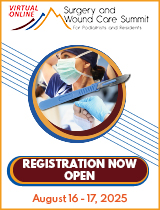|
|
|

|
Search
04/09/2019 Leonard A. Levy, DPM, MPH
Using DPM Degree Outside of Podiatry (Allen Jacobs, DPM)
As we all know, preparation for podiatric medical
practice today includes undergraduate podiatric
medical education and, as part of a continuum, 3
years of residency training. Not too many years
ago, the DPM completed podiatric medical school
and perhaps a year of residency. As a result,
education and training was just four years and
perhaps for a relatively small core of graduates,
another year of training. Today, much more
general medicine and surgery is a standard part
of podiatric medical school which is
significantly increased in the three years of
residency that follows.
But in spite of our greatly expanded education
and training and the fact that there is virtually
no difference in how we practice when compared to
specialists in medicine such as ENT,
ophthalmologists, dermatologists, the recognition
we receive is still considerably less. This lack
of recognition often manifests itself in such
areas as fee schedules, interprofessional
acceptance, separation from the MD and DO
mainstream, organizations that we are unable to
be part of, our role in hospitals, government
recognition, and perhaps other areas.
We have every reason to be proud of our
profession, the privileges we now have in
hospitals that did not exist years ago, the
recognition we acquired recently from the
Veterans Administration and, perhaps most of all,
how valuable we are in the care of our patients.
But despite this, we still do not have full
parity with the MD and DO community.
The time is long overdue to change this and make
the modifications needed to strengthen the
argument that we are equal to any specialist in
the profession called medicine. While this means
taking and passing the three parts of the USMLE
(taking the COMLEX examination would not be
practical since our curricula is devoid of
osteopathic principles and practice), it also
means inclusion of the components of the MD
curriculum that podiatric medical education does
not now require (i.e., didactic and clinical
experiences in ob-gyn, psychiatry, pediatrics).
Our colleges would need to become familiar with
the standards of accreditation for schools of
medicine and, if deficiencies are found, make the
additions that may be necessary. While this may
sound complicated, having personal and intense
experience for many years with the accreditation
process of medical schools, what now exists in
the curricula of podiatric medical schools can be
modified.
I am convinced that we can meet the standards of
medical education as they now are in existing
U.S. medical schools, pass the USMLE, receive the
MD degree, and, yes, continue to be proud of our
profession. This may not be an easy path but now
is the time to go down this road.
Leonard A. Levy, DPM, MPH, Ft. Lauderdale, FL
There are no more messages in this thread.
|
| |

|
|







